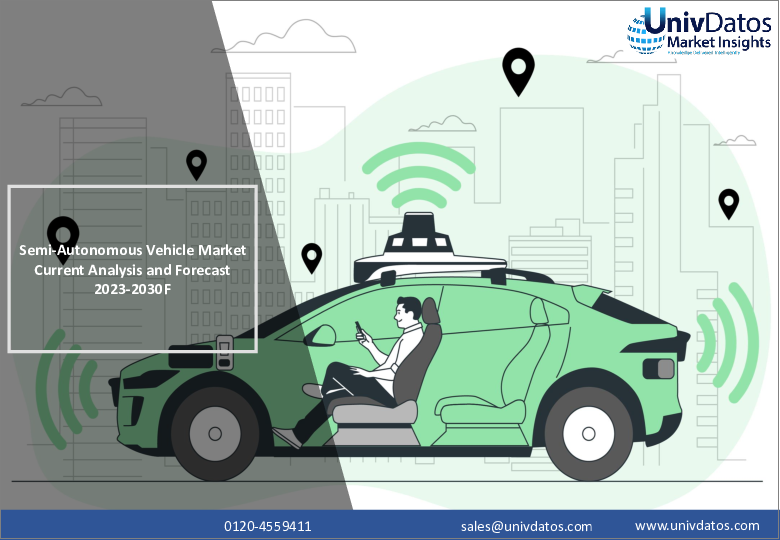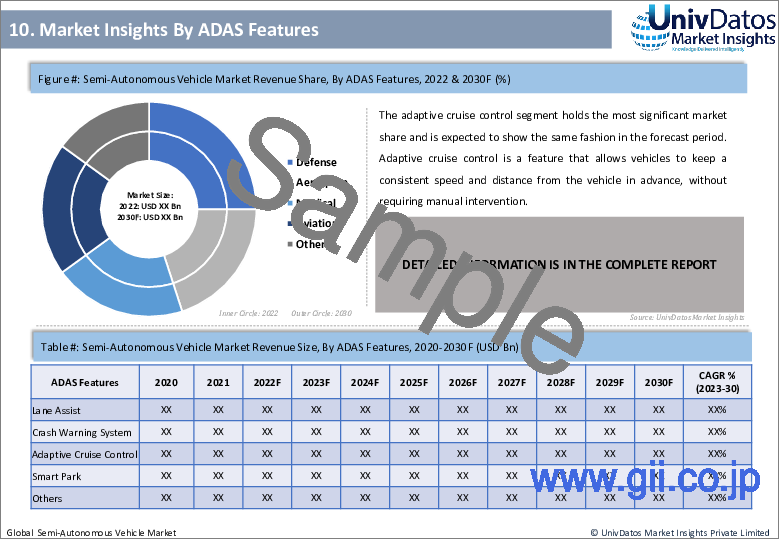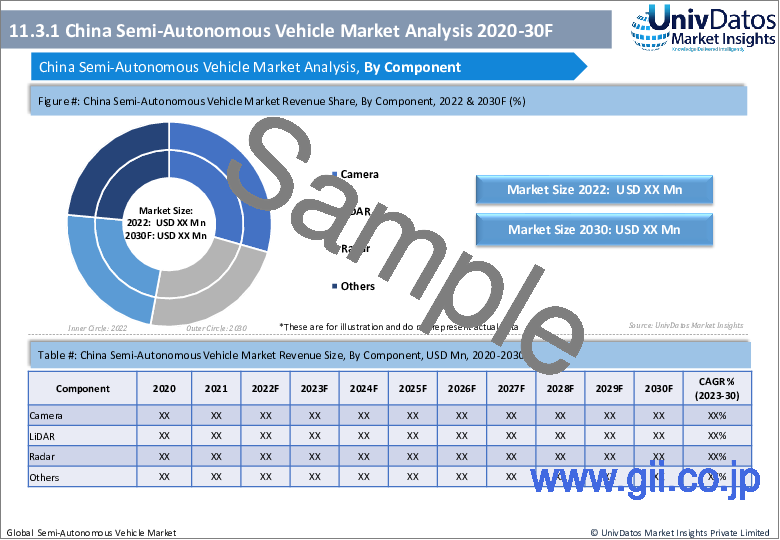|
|
市場調査レポート
商品コード
1346756
半自律走行車市場:現状分析と予測(2023年~2030年)Semi-Autonomous Vehicle Market: Current Analysis and Forecast (2023-2030) |
||||||
カスタマイズ可能
|
|||||||
| 半自律走行車市場:現状分析と予測(2023年~2030年) |
|
出版日: 2023年08月01日
発行: UnivDatos Market Insights Pvt Ltd
ページ情報: 英文 145 Pages
納期: 即日から翌営業日
|
- 全表示
- 概要
- 目次
半自律走行車市場は、自動車の安全機能に対する需要の高まりにより、約39.94%の安定した成長が見込まれています。乗客の保護とセキュリティに対する要求が急増していることが、半自律走行車の開発を推進する極めて重要な側面として浮上しています。注意散漫、居眠り、無謀な乗車事故が急増する中、交通安全に関する難問が増え続けているため、顧客はこれらの危険を軽減する可能性のある最先端のソリューションを求めています。例えば、2022年6月、世界保健機関(WHO)によると、2022年の交通事故による死亡者数は全世界で約135万人。このうち約94%(125万人)は、速度、アルコール、脇見運転、無謀運転、ベルトのない乗員などのヒューマンエラーに起因します。半自律走行車は、LiDAR、レーダー、コンピューター・ビジョンなどの高度な技術をシームレスに統合し、特定の状況下でステアリング操作、ブレーキ操作、加速などのタスクを自動的に行うことで、人間の見落としによる事故の確率を低減します。さらに、これらの自動車は、差し迫った脅威を 促進要因に積極的に警告し、直感的なインターフェースを通じて警戒行動を促すように設計されています。その結果、自動車分野での安全機能向上に対する要求が徐々に高まっており、半自律走行車市場に大きな成長の可能性をもたらしています。
自動化レベルに基づいて、市場はレベル1、レベル2、レベル3に分けられます。このうち、レベル3セグメントは、車線逸脱警告、アダプティブ・クルーズ・コントロール、衝突検知などの高度な運転支援機能により、予測期間中に最も高い収益を上げると予測されています。これらの機能は、乗員と他の道路利用者の全体的な安全性を向上させるために設計され、装備されています。さらに、車線逸脱警告システムは、 促進要因が意図せずに車線を逸脱した場合に警告を発し、 促進要因の注意散漫や眠気による衝突のリスクを低減するのに役立ちます。例えば、 促進要因の疲労や眠気は、2022年に世界で推定3万人の死因になっています。
コンポーネントに基づき、市場はカメラ、LiDAR、レーダー、その他に区分されます。カメラ分野は現在、収益面で市場を独占しており、予測期間中も支配的であると予想されます。これは、カメラが高解像度の画像と正確な物体検出を提供できるためで、半自律走行車にとって不可欠なコンポーネントとなっています。さらに、半自律走行車は、データを処理し、周囲の環境について賢明な判断を下す多数のセンサーとカメラに大きく依存しています。さらに、時間とスケールメリットにより、カメラの価格は年々下がり、半自律走行車にとって手の届く価格になっています。そのため、普及が進み、市場での地位がさらに強固なものとなります。
推進力タイプに基づき、市場はICEと電動に二分されます。二酸化炭素排出量を削減し、持続可能な輸送を促進するために、政府の規制が厳しい排出基準へと変化しているため、現在、電動セグメントが市場をリードしており、予測期間中もこのセグメントを支配すると予想されます。さらに、EVの初期コストは内燃機関車より高いが、燃料価格が安く、メンテナンスの必要性が低いため、運用コストは低いです。バッテリー技術が向上し続ければ、EVのコスト上昇幅は拡大し、その人気はさらに高まると思われます。EVは通常、瞬間的なトルクがあるため、内燃機関車よりも加速が速く、ハンドリングが良いです。このため、素早い応答が不可欠な半自律走行アプリケーションに最適です。
ADAS機能に基づき、市場は車線アシスト、衝突警告システム、アダプティブ・クルーズ・コントロール、スマート・パーク、その他に分けられます。アダプティブ・クルーズ・コントロール分野が最も大きな市場シェアを占めており、予測期間中も同様の傾向を示すと予想されます。アダプティブ・クルーズ・コントロールは、手動介入を必要とせず、車両が事前に一定の速度と車間距離を保つことを可能にする機能です。この機能は、レーダー、ライダー、またはカメラを使って周辺車両の速度と距離を検出し、その結果に応じてホスト車両の速度を調整します。アダプティブ・クルーズ・コントロールは、交通渋滞を緩和し、道路交通の保護を強化することができるため、近年絶大な人気を博しています。さらに、アダプティブ・クルーズ・コントロールを導入することで、燃料消費を削減し、保険料を引き下げることができるため、ユーザーには目に見える経済的メリットがもたらされます。
造船業界の市場導入に関する理解を深めるため、市場は北米(米国、カナダ、メキシコ、その他の北米地域)、欧州(ドイツ、英国、フランス、イタリア、スペイン、その他の欧州地域)、アジア太平洋地域(中国、日本、インド、韓国、その他のアジア太平洋地域)、世界のその他の地域における世界の存在に基づいて分析されます。北米地域は、早期採用と好調な自動車産業により、歴史的な年に市場を独占しました。さらに、政府の財政的・規制的支援が、同地域における半自律走行車の成長を加速させています。しかし、アジア太平洋地域は、多くの人々が農村部から都市部へ移住しており、急速な都市化が進んでいること、パーソナルモビリティの需要が増加していること、効率的な輸送ソリューションがアジア太平洋地域で飛躍的に増加していることなどの理由から、予測期間において最も急成長している地域であると予測されています。半自律走行車は、交通渋滞を緩和し、移動時間を短縮することができるため、この問題に対する実行可能な解決策を提供します。さらに、アジア太平洋地域の各国政府は、政策改革や資金援助を通じて、自律走行車や半自律走行車の導入を積極的に推進しています。例えば、中国は2023年8月、公共交通機関への自動運転車の利用に関する初の国家ガイドライン草案を発表しました。同月、湖北省武漢市と重慶市永川区の当局は、指定された地域で完全無人運転によるライドヘイリングサービスの運賃を徴収する許可をバイドゥに中国で初めて与えました。
目次
第1章 半自律走行車市場のイントロダクション
- 市場の定義
- 主な目標
- ステークホルダー
- 制限事項
第2章 調査手法または前提
- 調査プロセス
- 調査手法
- 回答者プロファイル
第3章 市場要約
第4章 エグゼクティブサマリー
第5章 世界の自動車用ソレノイドのCOVID-19感染症の影響
第6章 世界の自動車用ソレノイド収益、2020~2030年
第7章 自動化レベル別の市場洞察
- レベル1
- レベル2
- レベル3
第8章 コンポーネント別の市場洞察
- カメラ
- ライダー
- レーダー
- その他(超音波センサー、ステレオカメラ、その他)
第9章 推進力の種類別の市場洞察
- ICE
- 電気
第10章 ADAS機能別の市場洞察
レーンアシスト
衝突警報システム
アダプティブクルーズコントロール
スマートパーク
その他(横断交通警報、自動緊急ブレーキ、その他)
第10章 地域別の市場洞察
- 北米
- 米国
- カナダ
- メキシコ
- その他の北米地域
- 欧州
- ドイツ
- 英国
- フランス
- イタリア
- スペイン
- その他の欧州地域
- アジア太平洋
- 中国
- 日本
- インド
- 韓国
- アジア太平洋のその他諸国
- 世界のその他の地域
第12章 半自律走行車ダイナミクス
- 市場促進要因
- 市場の課題
- 影響分析
第13章 半自律走行車の機会
第14章 半自律走行車の動向
第15章 需要側と供給側の分析
- 需要側分析
- 供給側分析
第16章 バリューチェーン分析
第17章 価格分析
第18章 戦略的洞察
第19章 競合シナリオ
- 競合情勢
- ポーターのファイブフォース分析
第20章 企業プロファイル
- BMW AG
- Audi AG
- Daimler AG
- Ford Motor Company
- General Motors
- Volkswagen
- Mahindra & Mahindra Ltd.
- BYD Company Ltd.
- Tesla, Inc.
- Hyundai Motor Company
第21章 免責事項
A semi-autonomous vehicle is a kind of vehicle that combines elements of conventional manual control and autonomous driving. In a semi-self-reliant vehicle, the driver remains responsible for controlling the vehicle; however, the vehicle also provides assistance with certain tasks, which include steering, acceleration, and braking, using various sensors and actuators.
The semi-autonomous vehicle market is expected to grow at a steady rate of around 39.94%, owing to the growing demand for safety features in vehicles. The burgeoning requirement for passenger protection and security has emerged as a pivotal aspect propelling the development of semi-autonomous vehicles. As difficulty regarding street safety continues growing amidst the surge in distracted, drowsy, and reckless riding incidents, customers are looking for cutting-edge solutions that may mitigate those dangers. For instance, in June 2022, According to the World Health Organization (WHO), there were approximately 1.35 million fatalities globally due to road traffic accidents in 2022. Of these, around 94% (1.25 million) were attributed to human error, such as speed, alcohol, distracted driving, reckless driving, and unbelted occupants. Semi-autonomous automobiles seamlessly integrate sophisticated technologies along with LiDAR, radar, and computer vision to automatically take care of tasks like steering, braking, and acceleration under specific circumstances, thereby reducing the probability of accidents stemming from human oversight. Furthermore, these cars are designed to proactively warn drivers of impending threats and encourage vigilant behavior through intuitive interfaces. Consequently, the progressively escalating demand for improved safety features in the automotive sector has fostered enormous boom potentialities for the semi-autonomous vehicles market.
Based on the automation level, the market is divided into level 1, level 2, and level 3. Among these, the level 3 segment is predicted to generate the highest revenue in the forecast period due to its advanced driver assistance features like lane departure warnings, adaptive cruise control, and collision detection. These features are designed and equipped to improve the overall safety of the occupants and other road users. Moreover, Lane Departure Warning systems help alert drivers if they unintentionally drift out of their lane, reducing the risk of collision caused by driver distraction or drowsiness. For instance, Driver fatigue or drowsiness contributed to an estimated 30,000 deaths worldwide in 2022.
Based on components, the market is segmented into cameras, LiDAR, radar, and others. The cameras segment is currently dominating the market in terms of revenue generation and is expected to dominate in the forecast period. This is due to the fact that cameras are able to provide high-resolution images and accurate object detection, making them an essential component of semi-autonomous vehicles. Moreover, semi-autonomous vehicles heavily rely on a bunch of sensors and cameras that process the data and make wise decisions about the environment around them. Additionally, with respect to time and economies of scale, the price of cameras decreases year-by-year making them affordable to semi-autonomous vehicles. Thus, the adoption becomes more widespread, further solidifying their position in the market.
Based on propulsion type, the market is bifurcated into ICE and electric. The electric segment is currently the leading and is expected to dominate the segment in the forecast period due to the changing government regulations to strict emission standards to reduce carbon footprint and promote sustainable transportation. Moreover, despite the fact that the initial cost of EVs is higher than ICE vehicles, they've lower operational costs due to low fuel prices and lower maintenance requirements. As battery technology continues to improve, the cost gain of EVs is likely to grow, further boosting their popularity. EVs typically have faster acceleration and better handling than ICE vehicles due to their instant torque. This makes them best for semi-autonomous applications wherein quick response times are essential.
Based on ADAS features, the market is divided into lane assist, crash warning system, adaptive cruise control, smart park, and others. The adaptive cruise control segment holds the most significant market share and is expected to show the same fashion in the forecast period. Adaptive cruise control is a feature that allows vehicles to keep a consistent speed and distance from the vehicle in advance, without requiring manual intervention. This feature uses radar, lidar, or cameras to detect the speed and distance of surrounding vehicles, and adjusts the speed of the host vehicle consequently. Adaptive cruise control has gained enormous popularity in recent years due to its capability to reduce traffic congestion and enhance protection on the roads. Moreover, implementing adaptive cruise control can reduce fuel consumption and lower insurance premiums, providing tangible economic benefits to users.
For a better understanding of the market adoption of the shipbuilding industry, the market is analyzed based on its worldwide presence in countries such as North America (U.S., Canada, Mexico, and the Rest of North America), Europe (Germany, U.K., France, Italy, Spain, Rest of Europe), Asia-Pacific (China, Japan, India, South Korea, Rest of Asia-Pacific), Rest of World. North American region has dominated the market in the historic year due to the early adoption and strong automotive industry. Moreover, the persistent government financial and regulatory support has geared up the growth of the semi-autonomous vehicle in the region. However, the Asia Pacific is projected to be the fastest-growing region in the forecast period due to a number of reasons, such as rapid urbanization as more and more people are migrating from rural to urban areas, the demand for personal mobility has increased, and efficient transportation solutions have increased exponentially in the Asia Pacific region. Semi-autonomous vehicles offer a viable solution to this problem, as they can ease traffic congestion and reduce travel time. Furthermore, governments in the Asia Pacific region are actively promoting the adoption of autonomous and semi-autonomous vehicles via policy reforms and funding initiatives. For instance, in August 2023, China released its first national draft guideline on the use of self-driving vehicles for public transportation. That month, authorities in Wuhan, Hubei province, and Yongchuan district, Chongqing, granted Baidu the first permits issued in China to charge fares for fully driverless ride-hailing services in designated areas.
Some of the major players operating in the market include: BMW AG, Audi AG, Daimler AG, Ford Motor Company, General Motors, Volkswagen, Mahindra & Mahindra Ltd., BYD Company Ltd., Tesla, Inc., and Hyundai Motor Company.
TABLE OF CONTENTS
1 MARKET INTRODUCTION IN SEMI-AUTONOMOUS VEHICLE
- 1.1. Market Definitions
- 1.2. Main Objective
- 1.3. Stakeholders
- 1.4. Limitation
2 RESEARCH METHODOLOGY OR ASSUMPTION
- 2.1. Research Process of the Market
- 2.2. Research Methodology of the Semi-Autonomous Vehicle Market
- 2.3. Respondent Profile
3 MARKET SYNOPSIS
4 EXECUTIVE SUMMARY
5 GLOBAL AUTOMOTIVE SOLENOID COVID-19 IMPACT
6 GLOBAL AUTOMOTIVE SOLENOID REVENUE, 2020-2030F
7 MARKET INSIGHTS BY AUTOMATION LEVEL
- 7.1. Level 1
- 7.2. Level 2
- 7.3. Level 3
8 MARKET INSIGHTS BY COMPONENT
- 8.1. Camera
- 8.2. LiDAR
- 8.3. Radar
- 8.4. Others (Ultrasonic sensor, Stereo Cameras, Others)
9 MARKET INSIGHTS BY PROPULSION TYPE
- 9.1. ICE
- 9.2. Electric
10 MARKET INSIGHTS BY ADAS FEATURES
Lane Assist
Crash Warning System
Adaptive Cruise Control
Smart Park
Others (Cross Traffic Alert, Automatic Emergency Braking, Others)
10 MARKET INSIGHTS BY REGION
- 11.1 North America
- 11.1.1 U.S.
- 11.1.2 Canada
- 11.1.3. Mexico
- 11.1.4. Rest of North America
- 11.2 Europe
- 11.2.1. Germany
- 11.2.2. UK
- 11.2.3. France
- 11.2.4. Italy
- 11.2.5. Spain
- 11.2.6. Rest of Europe
- 11.3. Asia-Pacific
- 10.3.1. China
- 10.3.2. Japan
- 10.3.3. India
- 10.3.4. South Korea
- 10.3.5. Rest of APAC
- 11.4. Rest of the World
12 SEMI-AUTONOMOUS VEHICLE DYNAMICS
- 12.1. Market Drivers
- 12.2. Market Challenges
- 12.3. Impact Analysis
13 SEMI-AUTONOMOUS VEHICLE OPPORTUNITIES
14 SEMI-AUTONOMOUS VEHICLE TRENDS
15 DEMAND AND SUPPLY-SIDE ANALYSIS
- 15.1. Demand Side Analysis
- 15.2. Supply Side Analysis
16 VALUE CHAIN ANALYSIS
17 PRICING ANALYSIS
18 STRATEGIC INSIGHTS
19 COMPETITIVE SCENARIO
- 20.1. Competitive Landscape
- 20.1.1. Porters Fiver Forces Analysis
20 COMPANY PROFILED
- 20.1. BMW AG
- 20.2. Audi AG
- 20.3. Daimler AG
- 20.4. Ford Motor Company
- 20.5. General Motors
- 20.6. Volkswagen
- 20.7. Mahindra & Mahindra Ltd.
- 20.8. BYD Company Ltd.
- 20.9. Tesla, Inc.
- 20.10. Hyundai Motor Company






